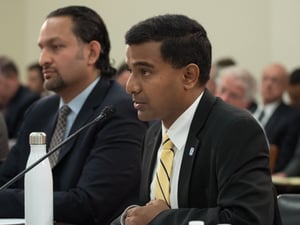“It’s a perfect tool for how we can improve reliability.” - Dr. Zachary Kuznar, Duke Energy
Last week, energy storage experts got to share their insights and vision for the future in front of the House Energy and Commerce Committee. The assembled panel of experts and government representatives discussed the growing role of energy storage in the U.S. electric grid and what should be considered in federal storage policy moving forward.
The hearing brought together speakers from across the country, from grid operators like the California ISO to utilities like Duke Energy, and Fluence was invited by the committee to share our perspectives.
The panel agreed that when there is a level playing field, storage is competitive with traditional grid infrastructure, and discussed how to ensure storage can participate broadly in planning and procurement processes.
|
“The economics of energy storage have reached the point where storage is a more cost-effective alternative to traditional single-use infrastructure, such as natural gas-fired peaking plants, and can provide critical grid services more effectively at a lower cost." - Kiran Kumaraswamy, Fluence Market Applications Director |
|
Understanding the capabilities of energy storage
The panel shed light on the many jobs energy storage can do for the grid, such as providing flexible capacity to meet peak demand, firming renewable generation, and serving as a transmission asset.
Utilities that have deployed storage shared their enthusiasm for the technology. Duke Energy's Dr. Zachary Kuznar spoke to how storage "provides [Duke Energy] these abilities to provide reliability for rural communities, deal with frequency regulation, help us integrate solar, and provide some peaking needs as well… It’s a perfect tool for how we can improve reliability." During the hearing, he shared that Duke plans to deploy a minimum of 145 MW of storage across its regulated businesses including 50 MW in Florida, and as he put it, "our plan is to go well beyond that."
California also took the limelight as a leader on deploying storage as a transmission asset, with Dr. Keith Casey of the California ISO sharing that "[CAISO] approved two storage projects this spring as alternatives to traditional wires, so there is an ability for RTOs/ISOs to consider storage in the planning process."
He also shared that CAISO is "examining how to allow storage resources that are approved as transmission assets, and therefore able to fully recover their costs through transmission rates, to also participate in the wholesale energy market and earn market revenues."
We applaud California's efforts, and look forward to seeing additional regional markets take similar steps. Several states are taking great steps towards including energy storage as part of their generation mix as part of Integrated Resource Planning (IRP) processes. (The Energy Storage Association’s Primer on Advanced Energy Storage in Integrated Resource Planning offers excellent background).
Now it's time for FERC to holistically consider energy storage in regional transmission planning processes across the country.
Making sure storage has a seat at the table
In addition to understanding the broad capabilities of storage, federal lawmakers were looking to understand what barriers still stand in the way and what can be done to speed the adoption of the technology. Energy storage is often the right tool for the job but is precluded from consideration due to outdated policies and processes in some markets.
Hearing testimony about the role of storage in aiding the integration of solar and wind, members of Congress present were eager to learn what changes to market rules and federal policies are needed in order to maximize renewable energy generation in areas outside of southwestern states like California and Arizona, such as the Midwest, Texas, the southeast and northeast. As an example, Congressman Tonko had specific questions on why it is important for states or grid operators to seal their commitment to storage through targets or incentives or policy. We think such measures provide long-term certainty for market participants with respect to energy storage providing its full value to customers.
|
“A modernized grid will need to be smarter, distributed and certainly more flexible. Storage technologies will be essential to achieve that mission." - Congressman Tonko (D-NY) |
Investor-owned utilities are expected to invest $90 billion in the U.S. transmission system through 2020, according to the Edison Electric Institute. Energy storage can help utilities address transmission challenges related to load growth, network congestion and renewable generation integration in a cost-effective manner, but storage must be included in the transmission planning processes in order to deliver these benefits.
The hearing made it clear that when the playing field is level, energy storage is proving to be a cost-competitive and compelling alternative to traditional infrastructure in a variety of use cases. The key is ensuring that storage can participate broadly in planning and procurement processes so that it can get full consideration against other resources when utilities and regulators weigh investment decisions, especially ones that affect ratepayers.
As Energy Storage Association (ESA) President Kelly Speakes-Backman put it, “These industry leaders - Fluence, Duke Energy and the California ISO - conveyed the opportunities for action so that the industry can move forward with even greater deployments of high-quality, cost-effective energy storage projects that benefit consumers. We could further progress through timely implementation of FERC Order 841 and 845 directives, through consideration of storage in transmission and other long-term planning processes, or through clarification that standalone storage is eligible for the federal ITC – we hope, all three.”
Hear more from Kiran and the rest of the panel by watching the recording of the hearing below:

















